
The Order of the Dragon was a monarchical chivalric order only for selected higher aristocracy and monarchs, founded in 1408 by Sigismund of Luxembourg, who was then King of Hungary and Croatia and later became Holy Roman Emperor. It was fashioned after the military orders of the Crusades, requiring its initiates to defend the cross and fight the enemies of Christianity, particularly the Ottoman Empire.

The Kingdom of Croatia entered a personal union with the Kingdom of Hungary in 1102, after a period of rule of kings from the Trpimirović and Svetoslavić dynasties and a succession crisis following the death of king Demetrius Zvonimir. With the coronation of King Coloman of Hungary as "King of Croatia and Dalmatia" in 1102 in Biograd, the realm passed to the Árpád dynasty until 1301, when the (male) line of the dynasty died out. Then, kings from the Capetian House of Anjou, who were also cognatic descendants of the Árpád kings, ruled the kingdoms. Later centuries were characterized by conflicts with the Mongols, who sacked Zagreb in 1242, competition with Venice for control over Dalmatian coastal cities, and internal warfare among Croatian nobility. Various individuals emerged during the period, such as Paul I Šubić of Bribir, who was representing the most powerful Croatian dynasty at the time, the Šubić noble family. These powerful individuals were on occasion able to de facto secure great deal of independence for their fiefdoms. The Ottoman incursion into Europe in the 16th century significantly reduced Croatian territories and left the country weak and divided. After the death of Louis II in 1526 during the Battle of Mohács and a brief period of dynastic dispute, both crowns passed to the Austrian House of Habsburg, and the realms became part of the Habsburg monarchy.
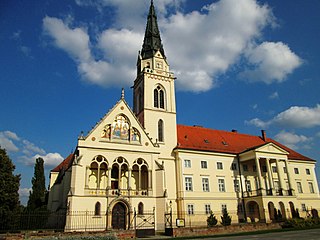
Križevci is a town in northern Croatia with a total population of 21,122 and with 11,231 in the town itself (2011), It is the oldest town in its county, the Koprivnica-Križevci County.
Kán is the name of a Hungarian noble family which gave bans (governors) to Croatia and Slavonia, voivodes to Transylvania, and palatines to Hungary in the 13th and 14th centuries.

The Kingdom of Croatia was part of the Lands of the Hungarian Crown, but was subject to direct Imperial Austrian rule for significant periods of time, including its final years. Its capital was Zagreb. It was also a part of the lands of the Habsburg monarchy from 1527, following the Election in Cetin, and the Austrian Empire from 1804 to 1867.

Nicholas II Garai was a powerful Hungarian baron who served as the Palatine of Hungary from 1402 until 1433 and the ban of Macsó, Usora, Só, Slavonia, Croatia and Dalmatia. He also ruled over the Braničevo, Syrmia, Bačka, Banat and Baranya regions through vassals. Together with his close ally Stibor of Stiboricz, he remained one of the richest and most powerful nobles in Hungary for over 30 years. Nicholas II Garai also served as de facto ruler of Hungary next to King Sigismund. In 1416 Sigismund extended their armorial bearings showing the Order of the Dragon and the Order of the Scarf. He presented the patent to his brother-in-law. Nicholas II's first wife was Theodora of Serbia, daughter of Prince Lazar of Serbia. In 1405, he married Anna of Cilli, sister of King Sigismund's second wife, Barbara of Cilli, thereby becoming brother-in-law of the King and Queen of Hungary. His granddaughter Anna was engaged to King Matthias Corvinus.

Bloody Sabor of Križevci or Bloody Parliament Session or Križevci Bloody Assembly was an organised killing of the former Croatian ban Stephen II Lackfi and his followers by King Sigismund in Križevci, Croatia, on 27 February 1397. The episode was part of a quarter-century-long fight over the Hungarian-Croatian crown after the death of Louis I of Hungary. During this prolonged struggle, Croatia was a stronghold of the Anjou-Durazzo party fighting against King Sigismund.
The Újlaki family, in old sources de Illoch, de Wylak, de Voilack etc., Hungarian: Újlaki) was a Croatian–Hungarian noble family, descended in the male line from Gug, a member of the lower nobility in the region of Lower Slavonia during the 13th century.
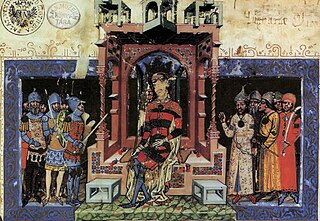
Nicholas Kont of Orahovica was a Croato-Hungarian nobleman, very powerful and influential in the royal court of king Louis the Angevin, serving as Count palatine. He was the forefather and founder of the Iločki noble family.
Andrew Lackfi was an influential nobleman and a successful military leader in the Kingdom of Hungary. He was Count of the Székelys between 1343 and 1350, Ban of Macsó from 1355 to 1356, and Voivode of Transylvania between 1356 and 1359.

Stephen II Lackfi was Ban of Croatia, Palatine of Hungary and the Voivode of Transylvania from the Lackfi family. He was murdered at the Bloody Sabor of Križevci by the followers of king Sigismund. His estates were confiscated by the crown and the bulk of it, in the region of Međimurje, sold to the king's father-in-law Hermann of Celje.

The Kurjaković family, also known as the Counts of Krbava, were a Croatian noble family that originated from the noble tribe of Gusić. It formed at the end of the 13th century, as descendants of Kurjak. They reached their peak as magnates between mid-14th and mid-15th century, having tight connections and high official positions at the Hungarian royal court, and dissolution in 1531 when the estates of magnate Ivan Karlović went to Nikola III Zrinski. Two members were Ban of Croatia, as well two were founding members of Order of the Dragon.
Nicholas (VII) from the kindred Hahót was a Hungarian baron and soldier, who served as Ban of Slavonia from 1343 to 1346 and from 1353 to 1356; and Ban of Croatia from 1345 to 1346 and from 1353 to 1356. In this capacity, he played a key role in the restoration of the Hungarian suzerainty over Croatia. Also known as Nicholas of Alsólendva, he was the progenitor of the powerful Bánfi de Alsólendva noble family.
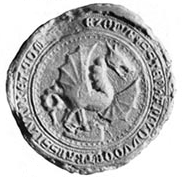
Stephen (I) Lackfi was an influential Hungarian nobleman and a successful military leader in the Kingdom of Hungary. He played a significant role in the Neapolitan campaigns of Louis the Great.
Lack from the kindred Hermán, also known as Lack of Kerekegyháza was an influential Hungarian nobleman, who served as Count of the Székelys from 1328 to 1343. He was the eponymous ancestor of the powerful and rich Lackfi family.
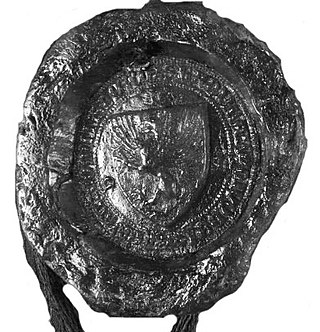
Ladislaus (I) Losonci was a powerful Hungarian baron, who served as Count of the Székelys from 1373 to 1376, and Voivode of Transylvania from 1376 to 1385 and from 1386 until his death. He was a staunch supporter of Mary, Queen of Hungary after 1382. In contemporary records, he was often called Ladislaus the Elder to distinguish him from his namesake relative Ladislaus II Losonci.

Emeric (I) Bebek was a powerful Hungarian baron, who rose to prominence during the last regnal years of King Louis I of Hungary. After 1382, he was a staunch supporter of Mary, Queen of Hungary. Recognizing Sigismund's accession to the throne, he was made Judge royal, then Voivode of Transylvania. He received numerous land donations, which founded the wealth and influence of his family in the 15th century.

Frank Szécsényi, also Francis, was a Hungarian baron and military leader, who was a staunch supporter of King Sigismund of Luxembourg. He participated in various military campaigns against the Ottoman Empire. In 1401, he joined the magnate conspiracy against Sigismund, but returned to the king's allegiance shortly thereafter, retaining his political influence until his death.
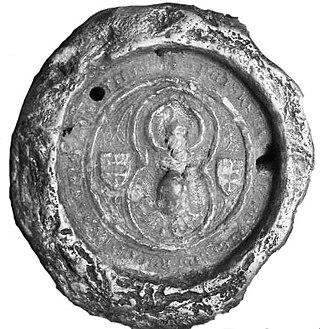
Simon Szécsényi, was a Hungarian baron and military leader, who was a staunch supporter of King Sigismund of Luxembourg since the 1380s. Joining a magnate conspiracy in 1401, he played a key role in the arrest of the king, but later was pardoned and retained his political influence until his death.














